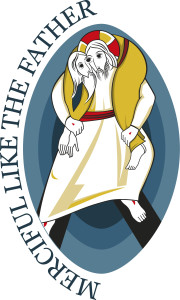Earlier this year, Pope Francis announced a special jubilee Year of Mercy beginning on the Feast of the Immaculate Conception (Tuesday, 8 December 2015) and ending on the Feast of Christ the King (Sunday, 20 November 2016). The focus of this year is to motivate Christians to engage in the corporal and spiritual works of mercy so that God’s love will be more greatly revealed to all.
A jubilee year is a special anniversary originating from the Jewish practice of celebrating God’s favour every fifty years. For Catholics, a jubilee is a time of special solemnity and piety. Ordinarily, a jubilee is held every twenty-five years. An extraordinary jubilee may be declared by the pope at any time in recognition of some historic or spiritual significance or occasion.
Pope Francis has named this extraordinary jubilee a Year of Mercy to highlight the importance of God’s loving message of compassion and forgiveness. This year-long celebration confirms the Church’s role in sharing God’s mercy. Through the corporal and spiritual works of mercy, the Christian faithful concretely participate in extending this message of mercy to the world.
The Works of Mercy
These are works or acts by which we offer others physical or spiritual help.
The corporal (or physical) works of mercy are:
- To feed the hungry.
- To give drink to the thirsty.
- To clothe the naked.
- To shelter the homeless.
- To visit the sick.
- To visit the imprisoned.
- To bury the dead.
The spiritual works of mercy are:
- To instruct the unlearned.
- To counsel and give hope to the doubtful.
- To admonish sinners.
- To bear wrongs patiently.
- To forgive offenses willingly.
- To comfort the afflicted.
- To pray for the living and the dead.
Ways of Growing in Mercy
There will be a number of initiatives on the diocesan, parish and personal levels to celebrate the Jubilee and grow in mercy. Three Books of Mercy will travel throughout the diocese to record acts of mercy by Catholics. These Books will be collected at the end of the Year of Mercy and sent to Pope Francis. For pilgrimage purposes, a holy door will be blessed at St. Patrick’s Cathedral in Thunder Bay.
Various projects will be introduced on a parish level to promote mercy in our local and global communities. For the Advent and Christmas seasons, we are currently asking you to become involved with our Advent Chain of Good Deeds. Each liturgical season will have a project of mercy in which our families will be able to participate.
Above all, this Year of Mercy is a personal invitation for every Christian to recommit themselves to their baptismal call to holiness and to transform the world through personal and random acts of mercy.
Holy Doors
Holy Doors are specially designed doors that symbolize the entrance into the presence of God. At the four papal basilicas in Rome these Holy Doors are bricked up during the intervening years between jubilees. They offer an opportunity for concrete action: as each person physically enters through the doorway, the individual displays a desire to enter a new life of grace.
For the Year of Mercy, seven major Holy Doors are located in basilicas throughout the world. In addition, every diocese will have a special door at its cathedral designated as a Door of Mercy to serve as a reminder that the experience of conversion and mercy is open to everyone throughout the world.
The Motto & Logo
The scriptural motto of the Year of Mercy is Merciful like the Father (Luke 6.36) and invites us to follow the merciful example of our Heavenly Father who asks us to neither judge nor condemn, but to forgive without measure.
The logo brings this motto to life through an image of Christ carrying a lost soul. As he once carried the cross up to Cavalry, he now carries humanity, with all our burdens and sufferings. The Good Shepherd looks with love into the eyes of humankind, inviting us to discover, in Christ, the merciful love of the Father.
The image of Christ and the lost soul is placed within an almond-shaped depiction of light, frequently used in early and medieval Christian icons. The colours progressively lighten, suggesting Christ’s movement of carrying us away from the darkness of sin toward the light of the Father’s love.

The Prayer
Lord Jesus Christ, you have taught us to be merciful like the heavenly Father, and have told us that whoever sees you sees Him. Show us your face and we will be saved. Your loving gaze freed Zacchaeus and Matthew from being enslaved by money; the adulteress and Magdalene from seeking happiness only in created things; made Peter weep after his betrayal, and assured Paradise to the repentant thief. Let us hear, as if addressed to each one of us, the words that you spoke to the Samaritan woman: “If you knew the gift of God!”
You are the visible face of the invisible Father, of the God who manifests his power above all by forgiveness and mercy: let the Church be your visible face in the world, its Lord risen and glorified. You willed that your ministers would also be clothed in weakness in order that they may feel compassion for those in ignorance and error: let everyone who approaches them feel sought after, loved, and forgiven by God.
Send your Spirit and consecrate every one of us with its anointing, so that the Jubilee of Mercy may be a year of grace from the Lord, and your Church, with renewed enthusiasm, may bring good news to the poor, proclaim liberty to captives and the oppressed, and restore sight to the blind.
We ask this of you, Lord Jesus, through the intercession of Mary, Mother of Mercy; you who live and reign with the Father and the Holy Spirit for ever and ever. Amen.
For More Information
